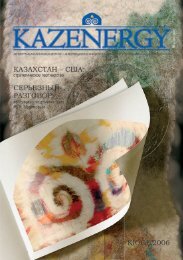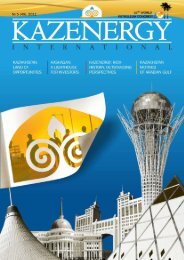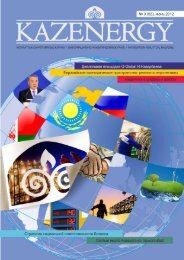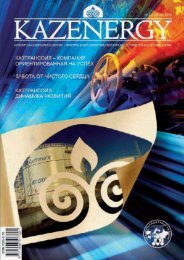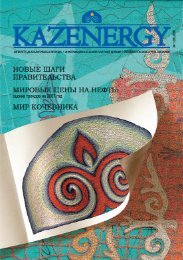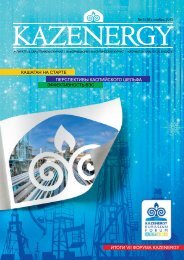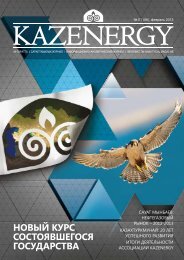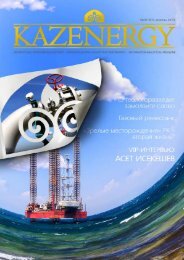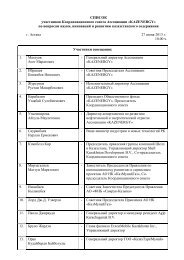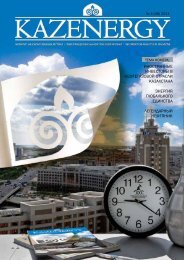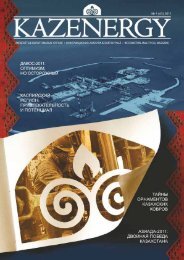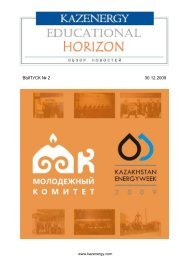KAZAKHSTAN UPSTREAM OIL AND GAS technology and R&d ...
KAZAKHSTAN UPSTREAM OIL AND GAS technology and R&d ...
KAZAKHSTAN UPSTREAM OIL AND GAS technology and R&d ...
Create successful ePaper yourself
Turn your PDF publications into a flip-book with our unique Google optimized e-Paper software.
5.1 Emergency response <strong>and</strong> disaster recovery<br />
96<br />
Solutions commentary<br />
The three solution groups cover<br />
n HSE management systems (QRA &<br />
management, emergency response<br />
preparation <strong>and</strong> safety processes & systems);<br />
n Oil spill/disaster response <strong>and</strong> mitigation,<br />
where well capping systems are normally<br />
considered to be required;<br />
n Personnel escape vehicles.<br />
Robust, effective HSE management systems<br />
are a critical pre-requisite for operations. The<br />
existing systems in Kazakhstan can be further<br />
optimised in the near term, for example by:<br />
n Quantitative risk management modelling tools<br />
for risk identification.<br />
n Increasing the scope of the oil spill response<br />
plan to include:<br />
n Location of facilities where oil spills<br />
are possible;<br />
n Detailed map of ecologically sensitive areas<br />
<strong>and</strong> review of seasonal sensitivity for each<br />
species;<br />
n List, location <strong>and</strong> type of equipment,<br />
transportation means, materials, personnel<br />
<strong>and</strong> working procedure concerning oil spill<br />
response;<br />
n List of applicable dispersants.<br />
n Incident documentation for collective benefit<br />
within <strong>and</strong> between organizations.<br />
n M<strong>and</strong>atory Safety Programs, e.g. STOP.<br />
Mechanical clean-up techniques comprise the<br />
physical containment of the oil within natural or<br />
man-made barriers, the subsequent removal of<br />
the oil from the surface <strong>and</strong> secondary storage<br />
for recovered oil <strong>and</strong> water.<br />
Chemical dispersants are another addition<br />
to the toolkit for cleaning up spills <strong>and</strong> have<br />
proven highly effective in the Arctic. Dispersants<br />
are like detergents, designed to enhance the<br />
breakup of oil into fine droplets that can then be<br />
dispersed <strong>and</strong> biodegraded in the sea. The use<br />
of dispersants offshore is generally recognized<br />
as an efficient way of rapidly treating large<br />
areas of spilled oil, providing greater protection<br />
to shorelines, birds <strong>and</strong> marine mammals.<br />
They can be applied from fixed-wing aircraft,<br />
helicopters, <strong>and</strong> vessels.<br />
Any required modifications to these<br />
technologies to ensure they are applicable in<br />
the Caspian should be established in the short<br />
term; with the required changes performed by<br />
2020.<br />
In the near/mid term, importing <strong>and</strong> deploying<br />
advanced well capping systems tailored to<br />
the shallow water operating environment<br />
can help in addressing challenges around<br />
disaster recovery for the Caspian. The capping<br />
solution will have to also be tailored for surface<br />
application, since North<br />
Caspian uses surface blowout preventers. A<br />
strategy proposed is to leverage capabilities<br />
from the recently established SWRP (subsea<br />
well response project) to identify the specific<br />
cold weather capping <strong>technology</strong> required for<br />
arctic conditions in Kazakhstan.<br />
Another solution, in the unlikely event of a<br />
blowout, is to always plan for a relief well<br />
that can pump cement or heavy mud into the<br />
original well to cut off the flow.<br />
At present escape <strong>and</strong> rescue vessels exist,<br />
however improved designs are sought that<br />
enable craft to operate under all conditions<br />
of open water <strong>and</strong> ice <strong>and</strong> a large range<br />
of water depths. Potential solutions for the<br />
North Caspian include the ARKTOS, <strong>and</strong><br />
Ice Strengthened Lifeboats (ISL). The latter is<br />
a specialized ice resistance Totally Enclosed<br />
Motor Propelled Survival Craft (TEMPSC)<br />
capable of safely operating in ice. After further<br />
design work, followed by proto-typing in the<br />
medium term, fully winter/platform capable EER<br />
vehicles should be available in 2020+.<br />
Kazakhstan Upstream oil & gas <strong>technology</strong> <strong>and</strong> R&D roadmap




